Ella Huxley, Student Veterinary Nurse.
Here at The Stocks Vets, if your pet is undergoing a sedation or anaesthetic one of our vets or nurses will discuss and offer intravenous (IV) fluid therapy or a ‘drip’ during the procedure and for the time that they are in the hospital with us.
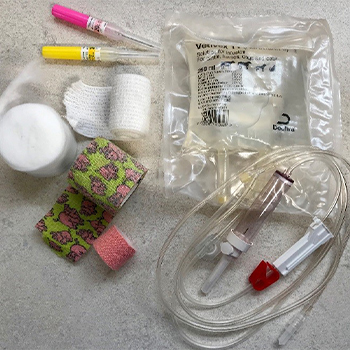
This is usually discussed at a pre operation check-up and on the morning of the procedure. There are many reasons that fluid therapy is beneficial, both during the anaesthetic and during the recovery.
During an anaesthestic the organs can be put under additional pressure – especially the liver and kidneys, as these excrete medications and drugs from the body. No anaesthetic is risk free, but having a patient on a drip can help decrease the risks of anaesthetic.
One of the key benefits of IV fluid therapy is that it helps maintain blood pressure (BP) during the anaesthetic. Blood pressure can drop as a side effect of the anaesthetic agents or blood loss. During any anaesthetic or sedation our registered veterinary nurses monitor the blood pressure of all patients closely. If there are any changes in blood pressure and a patient is on a drip, we can increase the rate of infusion to rectify any falls in BP. Fluid therapy can also aid in maintaining patients’ body temperature as the fluids can be warmed before entering the body. During surgical procedures patients are at risk of losing body heat as they are unable to regulate their own temperature. If the body temperature is too low it can slow recovery so warmed fluids can allow a quicker recovery.
Another benefit of providing our patients with fluid therapy is that it helps hydration that can be affected by starving a patient overnight before their procedure. It improves tissue perfusion and aids blood flow through the kidneys which can help with the excretion of drugs – furthermore speeding up recovery time.
It is important to remember that no anaesthetic is risk free and each pet is individual, so decisions about what is appropriate for your pet are best made after discussing with one of our vets or nurses.
'Jessi’
One of our patients is ‘Jessi’; a 10-year-old female Patterdale Terrier who was recently in for a dental operation and x-rays and had intravenous fluids during her stay with us.
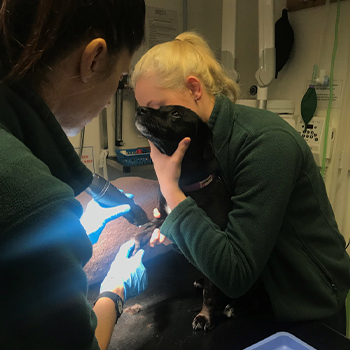
Here we talk through how we placed Jessi on a drip for her procedure:
Firstly, she was gently restrained by Ella and a small patch of her fur was clipped from one of her front legs to help the nurse placing the IV catheter (Jess) visualise the vein and allow an area to be cleaned. The clipped area was swabbed with an antibacterial solution and surgical spirit to prevent contamination or infection.
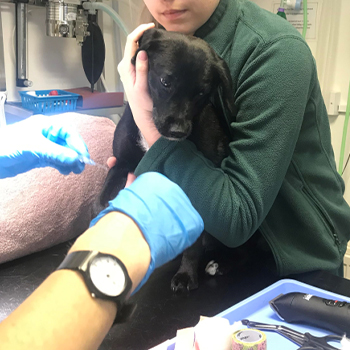
Once clipped, Ella raised the vein by putting a little pressure at the top of the leg which allowed the vein to fill with blood, facilitating placement of the catheter (otherwise known as a canula).
Jess then placed the catheter by inserting a needle into the vein and advancing the catheter. This was then taped into place using elastoplast to ensure Jessi could not dislodge the catheter.
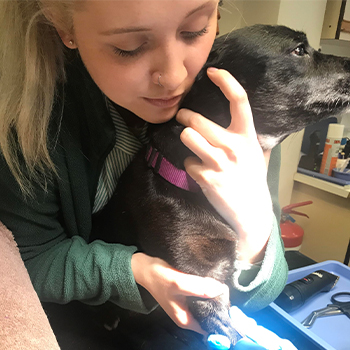
Jess then flushed the catheter with sterile fluid to ensure it was in place, neatly bandaged the leg and connected the fluids with a long drip line.
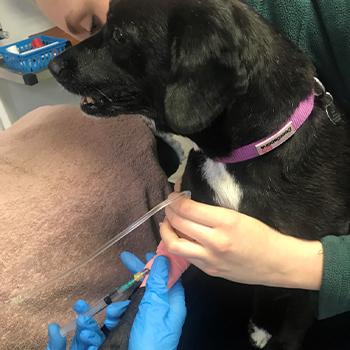
Jessi was then put into her kennel and her fluids attached outside of the cage so that she couldn’t interfere with them! The drip line was run through a machine or ‘infusion pump’ which regulates the speed and amount of fluids being administered.
During the anaesthetic the fluid rate was monitored and altered as necessary, according to blood pressure, hydration and other regular checks performed by the nurses during the procedure.
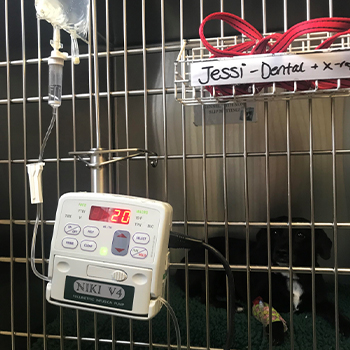
Jessi stayed on her drip throughout the day, and it was disconnected just before going home.
Jessi had a good recovery from her anaesthetic, and has since had several weeks of dressings and treatment for a broken bone in her leg. This last photo is a very happy Jessi after finally
having her leg cast removed!
